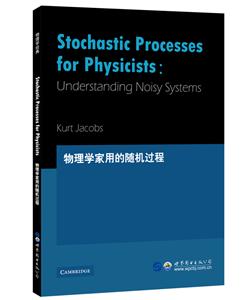扫一扫
关注中图网
官方微博
本类五星书更多>
-
>
宇宙、量子和人类心灵
-
>
考研数学专题练1200题
-
>
希格斯:“上帝粒子”的发明与发现
-
>
神农架叠层石:10多亿年前远古海洋微生物建造的大堡礁
-
>
二十四史天文志校注(上中下)
-
>
声音简史
-
>
浪漫地理学:追寻崇高景观
物理学家用的随机过程(影印版) 版权信息
- ISBN:9787519244668
- 条形码:9787519244668 ; 978-7-5192-4466-8
- 装帧:一般胶版纸
- 册数:暂无
- 重量:暂无
- 所属分类:>>
物理学家用的随机过程(影印版) 内容简介
随机过程广泛存在于物理学、生物学、化学和金融等领域。本书是一部教材,书中提供了应用于物理学的随机过程和随机计算的基本理论,特点是不需要测度论知识就可学习本书内容。为了便于读者理解和掌握所学知识,全书共有70余例习题。目次:概率论综述;微分方程;高斯噪声随机方程;随机过程的特性;高斯噪声的应用;高斯噪声用的数值方法;Fokker-Planck方程和反应扩散系统;跳跃过程;levy过程;现代概率论。附录:高斯积分计算。读者对象:物理学及相关专业的研究生和科研人员。
物理学家用的随机过程(影印版) 目录
Preface
Acknowledgments
1 A review of probability theory
1.1 Random variables and mutually exclusive events
1.2 Independence
1.3 Dependent random variables
1.4 Correlations and correlation coefficients
1.5 Adding independent random variables together
1.6 Transformations of a random variable
1.7 The distribution function
1.8 The characteristic function
1.9 Moments and cumulants
1.10 The multivariate Gaussian
2 Differential equations
2.1 Introduction
2.2 Vector differential equations
2.3 Writing differential equations using differentials
2.4 Two methods for solving differential equations
2.4.1 A linear differential equation with driving
2.5 Solving vector linear differential equations
2.6 Diagonalizing a matrix
3 Stochastic equations with Gaussian noise
3.1 Introduction
3.2 Gaussian increments and the continuum limit
3.3 Interlude: why Gaussian noise?
3.4 Ito calculus
3.5 Ito's formula: changing variables in an SDE
3.6 Solving some stochastic equations
3.6.1 The Ornstein-Uhlenbeck process
3.6.2 The full linear stochastic equation
3.6.3 Ito stochastic integrals
3.7 Deriving equations for the means and variances
3.8 Multiple variables and multiple noise sources
3.8.1 Stochastic equations with multiple noise sources
3.8.2 Ito's formula for multiple variables
3.8.3 Multiple Ito stochastic integrals
3.8.4 The multivariate linear equation with additive noise
3.8.5 The full multivariate linear stochastic equation
3.9 Non-anticipating functions
4 Further properties of stochastic processes
4.1 Sample paths
4.2 The reflection principle and the first-passage time
4.3 The stationary auto-correlation function, g
4.4 Conditional probability densities
4.5 The power spectrum
4.5.1 Signals with finite energy
4.5.2 Signals with finite power
4.6 White noise
5 Some applications of Gaussian noise
5.1 Physics: Brownian motion
5.2 Finance: option pricing
5.2.1 Some preliminary concepts
5.2.2 Deriving the Black-Scholes equation
5.2.3 Creating a portfolio that is equivalent to an option
5.2.4 The price of a "European" option
5.3 Modeling multiplicative noise in real systems: Stratonovich integrals
6 Numerical methods for Gaussian noise
6.1 Euler's method
6.1.1 Generating Gaussian random variables
6.2 Checking the accuracy of a solution
6.3 The accuracy of a numerical method
6.4 Milstein's method
6.4.1 Vector equations with scalar noise
6.4.2 Vector equations with commutative noise
6.4.3 General vector equations
6.5 Runge-Kutta-like methods
6.6 Implicit methods
6.7 Weak solutions
6.7.1 Second-order weak methods
7 Fokker-Planck equations and reaction--diffusion systems
7.1 Deriving the Fokker-Planck equation
7.2 The probability current
7.3 Absorbing and reflecting boundaries
7.4 Stationary solutions for one dimension
7.5 Physics: thermalization of a single particle
7.6 Time-dependent solutions
7.6.1 Green's functions
7.7 Calculating first-passage times
7.7.1 The time to exit an interval
7.7.2 The time to exit through one end of an interval
7.8 Chemistry: reaction-diffusion equations
7.9 Chemistry: pattern formation in reaction-diffusion systems
8 Jump processes
8.1 The Poisson process
8.2 Stochastic equations for jump processes
8.3 The master equation
8.4 Moments and the generating function
8.5 Another simple jump process: "telegraph noise"
8.6 Solving the master equation: a more complex example
8.7 The general form of the master equation
8.8 Biology: predator-prey systems
8.9 Biology: neurons and stochastic resonance
9 Levy processes
9.1 Introduction
9.2 The stable Levy processes
9.2.1 Stochastic equations with the stable processes
9.2.2 Numerical simulation
9.3 Characterizing all the Levy processes
9.4 Stochastic calculus for Levy processes
9.4.1 The linear stochastic equation with a Levy process
10 Modern probability theory
10.1 Introduction
10.2 The set of all samples
10.3 The collection of all events
10.4 The collection of events forms a sigma-algebra
10.5 The probability measure
10.6 Collecting the concepts: random variables
10.7 Stochastic processes: filtrations and adapted processes
10.7.1 Martingales
10.8 Translating the modem language
Appendix A Calculating Gaussian integrals
References
Index
展开全部
物理学家用的随机过程(影印版) 作者简介
《物理学家用的随机过程》作者Kurt Jacobs (美国,K. 雅各布斯),是美国马萨诸塞州立大学教授,2014年,出版了另一部著作Quantum Measurement Theory and its Applications。
书友推荐
- >
大红狗在马戏团-大红狗克里弗-助人
大红狗在马戏团-大红狗克里弗-助人
¥3.5¥10.0 - >
企鹅口袋书系列·伟大的思想20:论自然选择(英汉双语)
企鹅口袋书系列·伟大的思想20:论自然选择(英汉双语)
¥6.3¥14.0 - >
人文阅读与收藏·良友文学丛书:一天的工作
人文阅读与收藏·良友文学丛书:一天的工作
¥14.7¥45.8 - >
烟与镜
烟与镜
¥24.0¥48.0 - >
唐代进士录
唐代进士录
¥25.5¥39.8 - >
有舍有得是人生
有舍有得是人生
¥17.1¥45.0 - >
随园食单
随园食单
¥15.4¥48.0 - >
伊索寓言-世界文学名著典藏-全译本
伊索寓言-世界文学名著典藏-全译本
¥9.3¥19.0
本类畅销
-
4.23文创礼盒A款--“作家言我精神状态”
¥42.3¥206 -
4.23文创礼盒B款--“作家言我精神状态”
¥42.3¥206 -
一句顶一万句 (印签版)
¥40.4¥68 -
百年书评史散论
¥14.9¥38 -
1980年代:小说六记
¥52.8¥69





















